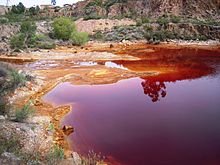Environmental Issues Caused by mining
Modern mining operations actively strive to mitigate potential environmental consequences of extracting metals, and such operations are strictly regulated in the United States. The key to effective mitigation lies in implementing scientific and technological advances that prevent or control undesired environmental impacts.
Operations and waste products associated with metal extraction and processing are the principal causes of environmental concerns about metal mining. Concerns include:
The largest physical disturbances at a mine site are the actual mine workings, such as open pits and the associated waste rock disposal areas. Mining facilities such as offices, shops, and mills, which occupy a small part of the disturbed area, are usually salvaged or demolished when the mine is closed. The open pits and waste rock disposal areas are the principal visual and aesthetic impacts of mining. Underground mining generally results in relatively small waste rock disposal areas ranging from a few acres in size to tens of acres (0.1 km2). These areas are typically located near the openings of the underground workings. Open pit mining disturbs larger areas than underground mining, and thus has larger visual and physical impacts. As the amount of waste rock in open pit mines is commonly two to three times the amount of ore produced, tremendous volumes of waste rock are removed from the pits and deposited in areas nearby.
Waste piles from processing, such as tailings impoundments, leach piles, and slag piles vary in size, but can be very large. The impoundments associated with some of the largest mills, such as at open pit copper mines, can cover thousands of acres (tens of km2) and be several hundred feet (about 100 m) thick. Heap leach piles can cover tens to hundreds of acres (0.1 to 1 km2) and be a few hundred feet (about 100 m) high. They resemble waste rock piles in location and size, but are more precisely engineered. Slag is a glassy by-product of smelting; slag piles can cover tens to hundreds of acres (0.1 to 1 km2) and be over 100 hundred feet (30 m) high.
These impacts remain on the landscape until the disturbed areas are stabilized and reclaimed for other uses, such as wildlife habitat or recreation areas, after mining has ceased.
Mobilization of metals in waste rock
Waste rock disposal areas are usually located as close to the mine as possible to minimize haulage costs. If not properly managed, erosion of mineralized waste rock into surface drainages may lead to concentrations of metals in stream sediments. This situation can be potentially harmful, particularly if the metals are in a chemical form that allows them to be easily released from the sediments into stream waters. When this occurs, the metals are considered to be “mobilized” and “bioavailable” in the environment.
In some cases, bioavailable metals are absorbed by plants and animals, causing detrimental effects. Although current U.S. mining and reclamation practices guided by environmental regulations minimize or prevent waste rock erosion into streams, disposal of waste rock in places where it could erode into surface drainages has occurred historically. These conditions still exist at some old or abandoned mines.










